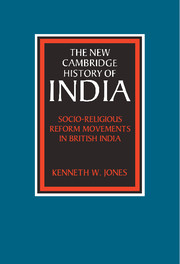Book contents
- Frontmatter
- 1 Concepts and context
- 2 Bengal and north-eastern India
- 3 The Gangetic core: Uttar Pradesh and Bihar
- 4 Punjab and the north-west
- 5 The central belt and Maharashtra
- 6 The Dravidian South
- 7 The twentieth century: socio-religious movements in a politicized world
- 8 Conclusion: religion in history
- Glossary of Indian terms
- Bibliographical essay
- Index
- THE NEW CAMBRIDGE HISTORY OF INDIA
- References
1 - Concepts and context
Published online by Cambridge University Press: 28 March 2008
- Frontmatter
- 1 Concepts and context
- 2 Bengal and north-eastern India
- 3 The Gangetic core: Uttar Pradesh and Bihar
- 4 Punjab and the north-west
- 5 The central belt and Maharashtra
- 6 The Dravidian South
- 7 The twentieth century: socio-religious movements in a politicized world
- 8 Conclusion: religion in history
- Glossary of Indian terms
- Bibliographical essay
- Index
- THE NEW CAMBRIDGE HISTORY OF INDIA
- References
Summary
Street preaching is very much in vogue here now-a-days. All along Anarkali, Hindu, Mohamedan, Christian, Arya and Brahmo preachers may be seen earnestly expatiating on the excellences of their respective creeds, surrounded by crowds of apparently attentive listeners.
Lahore Tribune, 30 March 1889THE CONCEPTUAL FRAMEWORK
Professional missionaries, polemical tracts, and new rituals of conversion, were only three of the components of religious innovation in South Asia during the nineteenth and twentieth centuries. Aggressive proselytism became the norm among sects and religions with new and refurbished forms of action, ranging from public debates on the meaning of scriptural sources to the use of printing to produce books, journals, and a multitude of pamphlets. Religious conflict was implicit in the competition for converts, and explicit in assassinations and riots. Sustaining religious pursuits were new organizations fashioned from the traditions of the subcontinent and modified by British culture. South Asians constructed religious societies fully equipped with elected officials, weekly meetings, annual published reports, bank accounts, sophisticated systems of fundraising, annual meetings, executive committees, subcommittees, bye-laws, and constitutions. Religious societies founded and successfully managed a number of organizations including hospitals, schools, orphanages, and relief programmes. Conflict, competition, and institution-building emerged from, and rested on, adherents to diverse ideologies made explicit in speech and writing. For many, religion became a matter of creeds that were explained, defined, and elaborated. It was an age of definition and redefinition initiated by socio-religious movements that swept the subcontinent during the years of British colonial rule.
Before turning to a discussion of the past, it is necessary to consider the concept of ‘socio-religious movements’ as used here, and its three crucial dimensions. The term ‘socio’ implies an attempt to reorder society in the areas of social behaviour, custom, structure or control.
- Type
- Chapter
- Information
- Socio-Religious Reform Movements in British India , pp. 1 - 14Publisher: Cambridge University PressPrint publication year: 1990

